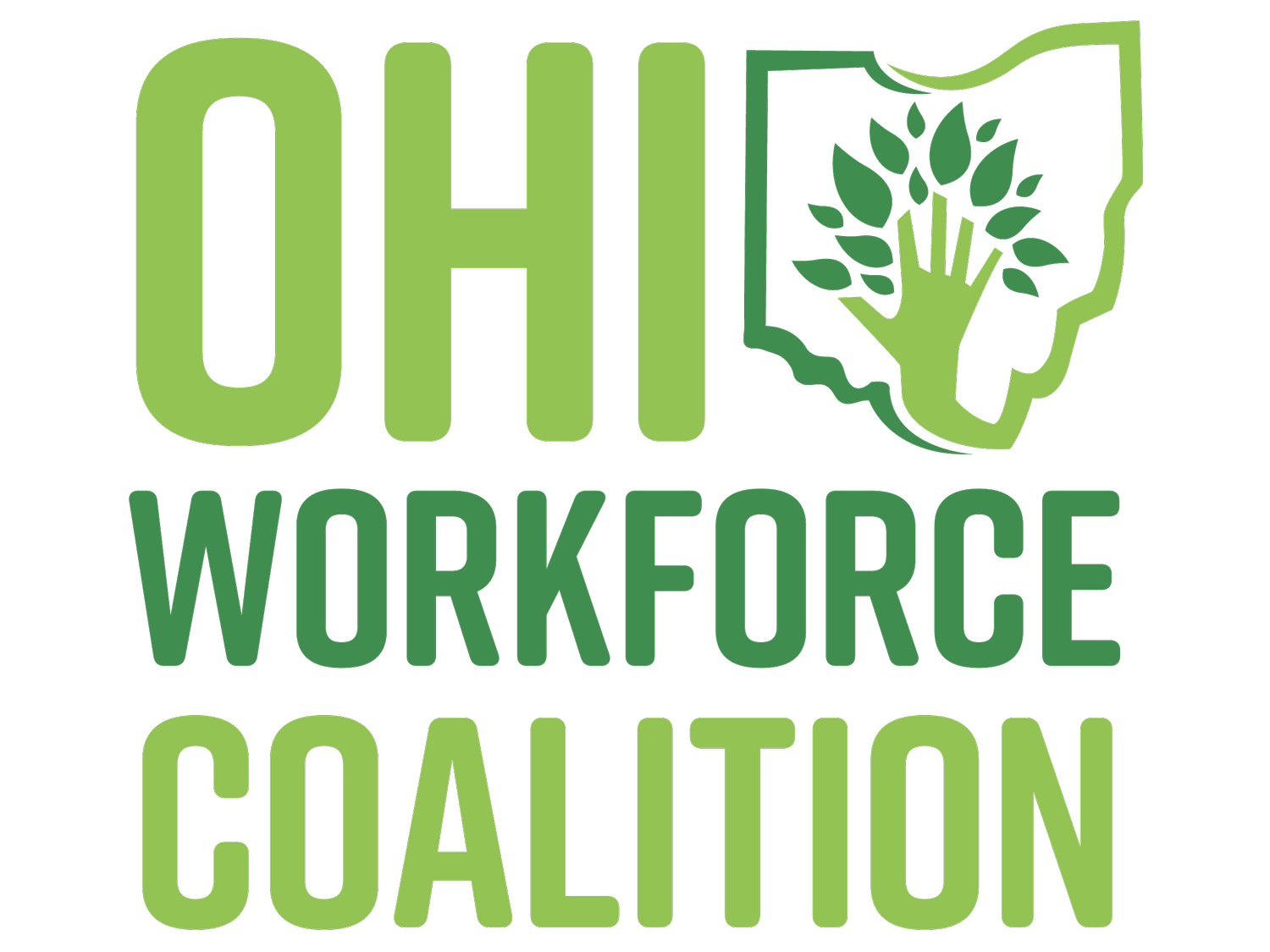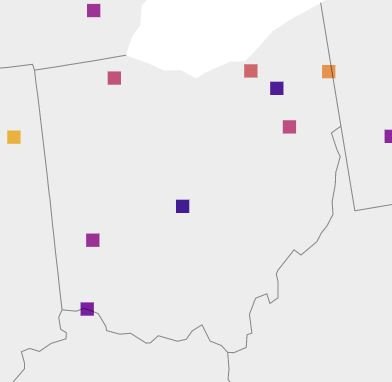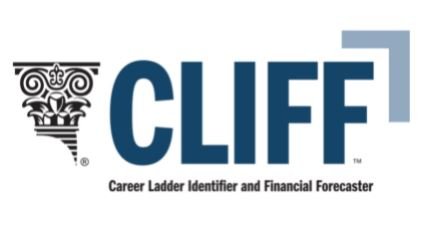Workforce-Related Tools, Sites, and
Other Information
When Working Isn’t Enough: Wages and Public Benefits in Ohio
The Ohio Workforce Coalition commissioned The Center for Community Solutions to investigate wages, public benefit eligibility, and benefit uptake by occupation in Ohio. Despite working - often full-time - many Ohioans still require benefit assistance (e.g., SNAP and Medicaid) to access food and medical care. This report outlines key findings from 10 low wage occupations, benefit usage by occupation, and policy recommendations. Fact sheets for each occupation (e.g., childcare worker, home health aide, assemblers and fabricators) include wages, number of job openings, projected growth, benefit eligibility, and whether Black workers are overrepresented in the low wage job.
Economic Mobility Alliance Ohio (EMAO)
The Ohio Workforce Coalition is a Founding Partner of Economic Mobility Alliance Ohio (EMAO). EMAO is an alliance of state and local advocacy, research, workforce development, and health and human service organizations and funders committed to ending the system of disincentives to work known as benefits cliffs that trap Ohioans in poverty. As a collaborative, we raise awareness and advocate for positive solutions to mitigate and eliminate benefits cliffs, to reduce disincentives to work, and create a more seamless pathway to economic stability for all Ohioans.
© venimo / Adobe Stock
Smart Growth Cities
Brookings's Workforce of the Future initiative released its Smart Growth Cities Tool: An interactive guide for economic and workforce planning. Access rich data on good jobs, underdeveloped industries, and building a workforce development plan.
© Monkey Business / Adobe Stock
Care Integration Senior Aide Guide
PHI, in collaboration with NFWS and NYC Workforce Funders Collaborative, developed a 10-step guide to introducing a Care Integration Senior Aide (CISA) into home care settings. Complete with templates, the guide also contains steps for data collection to assess the position's value to your agency.
© VectorMine / Adobe Stock
Systems Change Toolbox
National Fund for Workforce Solutions released its Systems Change Toolbox, which includes a variety of tools organized by phase of change (e.g., think, act, structure) and topic (e.g., evaluation, equity, strategy). From "Analyze a System From Multiple Perspectives" to "Use Data in Systems Change," there's a tool for you.
© Rawpixel.com / Adobe Stock
The Black Progress Index
Brookings and the NAACP came together to create The Black Progress Index. The index focuses on social conditions - like business ownership, income, and higher education rates - related to life expectancy. You can access the data, graphs, and more information about the index by clicking here.
© andres garcia / Pexels
State Digital Equity Scorecard
National Skills Coalition and its partners released the State Digital Equity Scorecard to assess the digital opportunity gap by state. Measures include availability of online digital skills training, worker training funds, technology apprenticeships, state broadband plans, and more.
Ohio ARPA Spending Tracker
Advocates for Ohio’s Future and Ohio Poverty Law Centered created a tracker to detail how Ohio has and is spending over $5 billion in state and local American Rescue Plan Act (ARPA) funds. Check out the tracker here. AOF and OPLC also released a report outlining how the funds were spend and recommendations for spending remaining funds.
© Pexels
Semiconductor Career Explorer
We’re hearing a lot about semiconductors lately. Thankfully, CAEL and SEMI Foundation developed a semiconductor-related career explorer to help navigate the industry. With this tool, you can find training opportunities, discover what job best suits you, and navigate job pipelines (e.g., military to semiconductor jobs).
National Equity Atlas
The National Equity Atlas is a comprehensive resource for data disaggregated by race, gender, and other characteristics - down to the county level. The aim of the National Equity Atlas is to provide racial and economic equity data to catalyze strategies and policies that promote racial and economic equity.
WIOA Dashboards
Check out FutureWork System’s WIOA data for Ohio and across the country. Need a WIOA (Workforce Innovation and Opportunity Act) overview? We recommend National Skills Coalition’s WIOA refresher.
Labor Market Inclusion by State
The Federal Reserve Bank of Cleveland provides labor market inclusion data and charts by state. The four measure focus on disparities between Black and white populations, including Ohio.
Career Ladder Identifier and Financial Forecaster (CLIFF) 1
The Federal Reserve Bank of Atlanta provides a demonstration of CLIFF dashboards, including a career path planner and budgeting tool, how public assistance and career paths related, and guaranteed income.
Understanding the Infrastructure Investment and Jobs Act (IIJA)
Brookings’s Federal Infrastructure Hub can help you better understand the Infrastructure Investment and Jobs Act (IIJA), including funding areas, programs, and other resources.
Economic Mobility Catalog
Results for America’s Economic Mobility Catalog lets you explore evidence-based strategies, programs, and policies by desired outcome or issue area. Issue areas include: workforce development, community development, financial security, and youth development.
Worker Voice Survey
Aspen Institute created a survey for workforce organizations to capture worker voice. You can download the report, Centering Worker Voice in Employer Engagement and Program Design: A Tool for Conducing Worker Surveys for Workforce Organizations, with sample survey language by clicking here.
Job Quality Tools Library
Did you know that Aspen Institute has a library of job quality-related tools? Access resources to define, assess, and strength job quality across different sectors (e.g., policy, economic development, worker voice) and aspects of job quality (e.g., equity, benefits, wages, legal rights). Click here to browse the library.
Workforce Equity Dashboard
National Fund for Workforce Solutions’s Workforce Equity Dashboard allows you to explore worker, employer, and community data by metro region to understand racial equity gaps in outcomes for workers (e.g., family-sustaining wage), employers (e.g., workforce diversity), and communities (e.g., reliable transportation access).
National Resources
State Resources
Ohio Workforce Coalition
Columbus, Ohio
Email: info@ohioworkforcecoalition.org




















